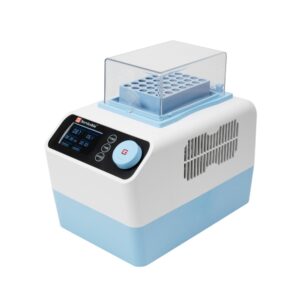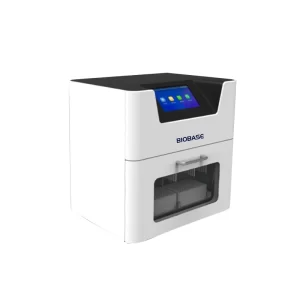$8,489.00 – $12,270.00
BK-HS96 is a high throughput, high sensitivity automatically extracted nucleic acid purification equipment, matching nucleic acid extraction kits is used to automatically complete te extraction of samples nucleic acid, flexible, stable result, low cost, equipped with efficient filtration device and safety gate design, it can effectively avoid cross infection and ensure the quality of nucleic acid extraction, guarantee the quality of nucleic acid.

Biobase is a global company specializing in laboratory equipment and biotechnology products. Founded in China, Biobase offers a wide range of products, including biosafety cabinets, laboratory refrigerators, centrifuges, and other essential laboratory instruments.



Nucleic acid extraction systems are used for automating DNA and RNA extractions from samples such as serum, body fluids, plasma, and other virus-infected cell cultures. It uses the magnetic bead method for high-quality nucleic acid extraction in the biological laboratory and clinical medicine department. The nucleic acid produced from this extraction can be used directly for qPCR and qRT-PCR detection.
The extraction of nucleic acid is a crucial part of molecular biology. It is considered a starting point for thousands of downstream applications such as diagnosis, clinical research, product development, and other experiments. Nucleic acid can only be useful in scientific processes if it retains high quality. For years, scientists relied on manual nucleic acid extraction, but this process was time-consuming, required a lot of human work, and increased contamination risk. An automated extraction system was designed to simplify and increase the output of DNA/RNA extraction. It significantly reduces the working time and labor costs and increases the safety and quality of the overall extraction process.
Parameters | BK-HS32 | BK-HS96 |
|---|---|---|
Extraction Method | Magnetic beads | Paramagnetic particle method |
Sample Capacity | 32 | 96 |
Processing Volume | 20~1000µl | 20~500µl |
Extraction Time | 15~60min | 11~60min |
Magnetic Bead Recovery | >98% | >98% |
Magnetic Rod Flux | ≥4500Gs | ≥4500Gs |
Temperature Range | Adjustable heating function, RT~100 ℃ | RT~105℃ |
Oscillating Mixing | Vertical mixing, low, medium, high three gears adjustable | |
Protection Function | Star up self-checking, power off protection, high temperature alarm, over temperature protection, motor protection | Shock function |
Desinfection Method | 8W UV lamp | UV light |
Illuminating Lamp | 3.4W LED lamp | |
Operation Interface | 10.1 inch capacitive touch screen Windows system | Windows system |
Project Storage | >1000 | >1000 |
Interface | 2 USB port, optional LAN port | 80 |
Package Size(W*D*H) | 538*538*750mm | 940*710*910mm |
The nucleic acid extraction system involves the separation of nucleic acids from their complex structures by utilizing complementary hybridization. (Ali, Rampazzo, Costa, & Krieger, 2017)
This system uses a kit that contains magnetic beads and buffers that play a significant role in extraction. When the magnetic beads, along with the sample, are placed inside the extraction machine, these magnetic beads bind to the nucleic acid present in the sample and get attached to the rods found inside the machine. The beads and nucleic acid are then transferred for further processing, i.e., lysing, washing, and elution. After these steps are completed, the nucleic acid obtained is high quality and pure.
The inside chamber of the nucleic acid extraction system consists of 6 plate positions. Each plate varies in its function, i.e., plate 1 and 6 has vibration and heat function, whereas plate 5 has a heat and refrigeration function. It also has a magnetic sleeve frame, magnetic rod, and anti-drip plate, which moves inside the chamber to perform the extraction process. Moreover, the extraction system is equipped with various safety functions such as door opening protection, UV protection, and a wide window for better observation and safer results.
A nucleic acid extraction system ensures greater consistency, reliability, high sample throughput, and better-quality data by automating the extraction process. The fewer manual handling reduces the risk of contamination, saves time, and improves workflow efficiency.
Yoon, Kang, Hwang, Song, & Jeong, (2016) conducted a study to purify nucleic acids from clinical stool samples using two different methods, i.e., a semi-automatic magnetic bead-based kit and a manual membrane column-based kit. The results predicted that the magnetic bead-based kit was more user-friendly and produced high yields in both DNA and RNA compared to the manual membrane column-based kit.
An automated nucleic acid extraction system was used to improve the accuracy of the HybriBio Human Papillomavirus (HPV) test for cervical swab samples. It was observed that the automated system produced high-quality DNA compared to DNA extracted from a cell lysis kit. The analytical sensitivity of testing and the reproducibility was increased. It increased accuracy and amplified the efficiency of HPV detection. (Wang, Zhou, Ren, Xia, & Guo, 2017)
Strength
The nuclear acid extraction system streamlines the extraction process and helps achieve uniformity in extraction steps such as lysis, washing, and elution. It saves your time, speeds up your workflow, and leaves you with samples ready for downstream applications. The nucleic acid extracted from this process is of high quality and pure. As the extraction process is automated, it greatly reduces the risk of contamination and errors. Thus, providing more reliable and consistent data.
Moreover, it has the capability to process a large number of samples with greater speed. Depending upon the reagent, the extraction system takes about 15 to 60 minutes to complete the extraction process. This significantly increases the scope of research. The bright and spacious window makes it easier for the workers to monitor the working conditions. The UV light disinfection feature reduces cross infection and contamination of samples.
Limitations
The major drawback of the nucleic acid extraction system is that it is quite expensive and requires a high throughput of samples. It also poses a risk of contamination of samples with magnetic beads and can generate false-positive results due to contamination. (Knepp, Geahr, Forman, & Valsamakis, 2003) Moreover, laboratory professionals are required to handle extraction systems.
Lorem ipsum dolor sit amet, consectetur adipiscing elit. Ut elit tellus, luctus nec ullamcorper mattis, pulvinar dapibus leo.
| Brand | Biobase |
|---|---|
| Sample Capacity/ Quantity | 32 samples, 96 samples |
| External Size (W*D*H) | 450*440*532mm (BB-BK-HS32) |
| Package Size(W*D*H) | 538*538*750mm (BB-BK-HS32), 940*710*910mm (BB-BK-HS96) |
| Gross Weight | 37kg(BB-BK-HS32), 110kg (BB-BK-HS96) |
| Power Supply | AC100~240V, 50Hz/60Hz |
You must be logged in to post a review.
There are no questions yet. Be the first to ask a question about this product.
Monday – Friday
9 AM – 5 PM EST
DISCLAIMER: ConductScience and affiliate products are NOT designed for human consumption, testing, or clinical utilization. They are designed for pre-clinical utilization only. Customers purchasing apparatus for the purposes of scientific research or veterinary care affirm adherence to applicable regulatory bodies for the country in which their research or care is conducted.
Reviews
There are no reviews yet.